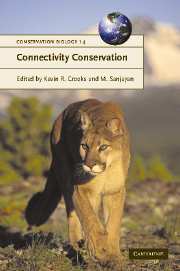1 - Connectivity conservation: maintaining connections for nature
Published online by Cambridge University Press: 24 May 2010
Summary
For the first time in Earth's long history, one species – Homo sapiens – completely dominates the globe. Over 6 billion people now inhabit the planet, and that number is growing at an alarming rate. In sharp contrast to previous eras, we drive, fly, telephone, and e-communicate from even the most remote regions of Earth. With the aid of technology, no significant segment of our population is truly isolated. Today, it is possible to make a cell phone call from the Serengeti, or live “off the grid” from in-holdings within the midst of national forests or wilderness areas in North America. With the notable exception of weedy species that thrive amidst the disturbances we create, predictably, the more “connected” we become, non-human life with which we share this planet becomes increasingly disconnected.
The vast reach of humans and the resulting parcelization of natural landscapes are of major concern to conservation scientists. Indeed, horror stories about habitat fragmentation appear in every book about conservation biology, make appearances in high-school textbooks, and are featured regularly in our leading newspapers and magazines. And conservation biologists are not alone in their concern about massive habitat destruction and fragmentation. Members of the public also have been inspired to promote special efforts for connecting landscapes in our increasingly dissected world.
While the vision of connected landscapes may be compelling, the practice of preventing fragmentation and conserving connectivity is not a simple matter.
- Type
- Chapter
- Information
- Connectivity Conservation , pp. 1 - 20Publisher: Cambridge University PressPrint publication year: 2006
References
- 62
- Cited by

